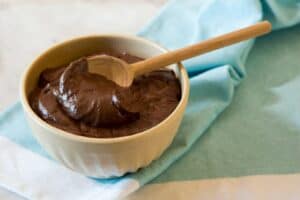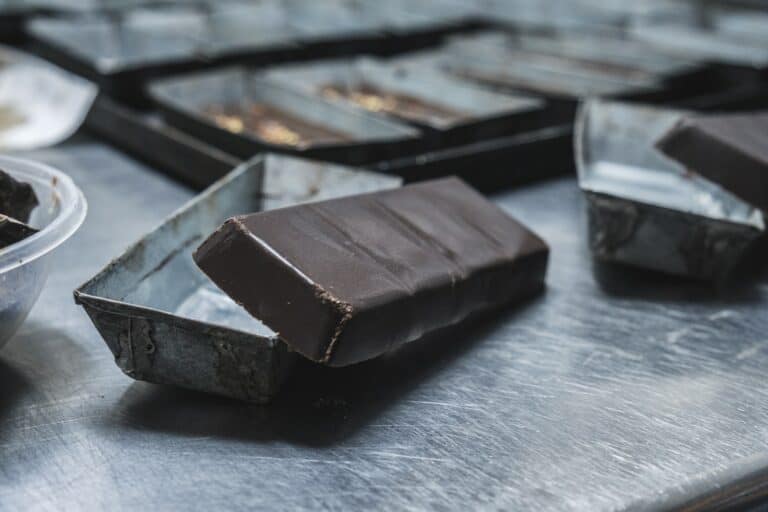I’ve always been intrigued by the process behind conching chocolate, especially when enjoying a decadent piece of dark chocolate or a creamy bar of milk chocolate. You might be wondering, what is conching and how does it contribute to the irresistible, smooth texture and rich flavor of chocolate? In this article, we’ll dive into the details of conching chocolate and its significance in the chocolate making process.
To understand conching, we must first explore the basic chocolate components like cocoa beans, cocoa butter, and sugar particles. Chocolate making starts with cocoa beans, which are roasted, separated into cocoa nibs, and ground to create a chocolate mass. This mass consists of cocoa solids and cocoa butter. The chocolate mass then goes through a series of refining and conching steps to achieve the desired taste and texture. The conching process involves heating, agitating, and aerating the chocolate mass, allowing the sugar crystals to dissolve, cocoa particles to become smaller, and any undesirable volatile compounds to evaporate. During conching, ingredients like sugar, milk powder, or more cocoa butter may be added to create a range of flavors and textures like milk chocolates, dark chocolates, and plain chocolate.
The role of conching in chocolate production is crucial for achieving a final product that’s both smooth and flavorful. As the liquid phase of the process allows sugar particles and cocoa particles to get evenly distributed, the result is a uniform, glossy, and smooth chocolate. Additionally, the conching temperature helps with eradicating any remaining acetic acid, further enhancing the final chocolate flavor. Now that you have an insight into the fascinating world of chocolate conching, next time you savor a piece of chocolate, remember the intricate process and dedication of chocolate makers to deliver a truly delectable experience.
Enhance your culinary experience with our guide to finding Perfect Chocolate and Wine Combinations that will delight your palate.

The Origins of Conching Chocolate
Before diving into conching chocolate, let’s first understand what it is. Conching chocolate is a crucial step in the chocolate making process that helps develop the desired chocolate flavor and texture. It got its name from the vessel originally used for the process, which was akin to a sea conch in appearance.
To appreciate the role of conching in chocolate production, it’s essential to know the basic chocolate components. Chocolate primarily consists of cocoa solids, cocoa butter, and sugar. These ingredients are present in varying proportions in different types of chocolate, like milk chocolate and dark chocolate.
Enhance your culinary experience with our guide to finding Perfect Chocolate and Wine Combinations that will delight your palate.
The conching process begins after the cocoa beans have been ground into cocoa mass (also known as cocoa liquor) and mixed with sugar and other ingredients like milk powder in case of milk chocolates. The cocoa mass and other ingredients are then further ground to form a paste-like fluid mass, hence creating a smoother and more homogenous blend.
Now, let’s explore the importance of conching in the development of chocolate flavor and the texture of the chocolate. During conching, the chocolate mass is heated under controlled conditions to facilitate the release of acetic acid and other undesirable volatile compounds that might affect the taste of the final product. This step also helps to reduce the size of sugar particles and cocoa particles, leading to a more refined, smooth chocolate that melts in the mouth.
Moreover, conching temperature plays a vital role in the formation of chocolate flavor. It’s been observed that higher conching temperatures tend to produce more cocoa butter equivalents and consequently a richer chocolate taste.
Discover creative ideas for unforgettable events with our tips on choosing the best Chocolate Party Favors for your guests.
In summary, conching chocolate has evolved as an indispensable technique for chocolate makers aiming to achieve a desired texture and flavor in their chocolate products. By integrating two separate processes – refining and conching – they are able to produce a well-rounded finished chocolate that appeals to different palates. Adding to that, the continuous advancements in chocolate science allow for better control over the chocolate manufacturing process, ensuring that we, the consumers, can enjoy a wide array of remarkable and delectable chocolate treats.
Exploring the Conching Process

When diving into the world of conching chocolate, it’s essential to understand the process and its significance. Conching is a crucial step in chocolate production that impacts the texture, flavor, and overall quality of finished chocolate.
The conching process begins with cocoa beans that have been roasted, ground, and converted into a chocolate mass or cocoa mass. This mixture consists of cocoa solids, cocoa butter, and other ingredients such as sugar and milk powder, depending on the type of chocolate being made. For instance, milk chocolates contain more milk powder and sugar than dark chocolate, which focuses on higher percentages of cocoa solids.
Immerse yourself in the delectable comparison of Belgian and Swiss Chocolate to find out which variety stands out.
During conching, chocolate makers mechanically grind the chocolate mass to break down the sugar crystals and cocoa particles further. This step refines the overall texture of the chocolate. Moreover, it helps to distribute the cocoa butter equivalents evenly, allowing the liquid chocolate or cocoa liquor to become silky smooth.
Throughout the conching process, the chocolate flavor and aroma develop as well. Undesirable volatile compounds, such as acetic acid, are released, resulting in a more pleasing taste. Additionally, the conching temperature plays a vital role in determining the final quality and smoothness of the chocolate.
It’s important to note that the conching process is distinct from the refining process, although they’re often interconnected. Refining and conching are two separate processes aimed at improving the texture, flavor, and overall quality of the chocolate. While refining reduces the size of the solid particles, conching focuses on the even distribution of the liquid phase and removing unwanted compounds.
In summary, the conching process is a crucial step that all chocolate makers must undertake to produce high-quality chocolate products with smooth textures and balanced flavors. Understanding this essential technique can deepen our appreciation for the intricate art and science behind chocolate manufacturing.
Understanding the Benefits and Effects
Conching chocolate is an essential step in the chocolate making process, and it has a significant impact on the final product. This includes the texture, flavor, and overall quality of the chocolate. We’ll discuss how conching process affects various types of chocolate, from milk chocolate to dark chocolate.
In the chocolate making process, cocoa beans are first processed into cocoa nibs, which are then ground into a liquid, known as cocoa liquor or cocoa mass. This liquid comprises cocoa solids and cocoa butter. To create various types of chocolates, such as milk chocolates, sugar, milk powder, and additional cocoa butter are combined with the cocoa mass. Conching is vital in integrating these ingredients and refining them into the final chocolate product.
Learn how moderate chocolate consumption can support heart health in our detailed exploration of Chocolate and Blood Pressure.
The Role of Conching in Chocolate Production
As chocolate makers carry out the conching process, the texture of the chocolate is drastically transformed. During conching, sugar crystals and cocoa particles are ground down to become smaller, resulting in a smoother end product. Solid particles, such as sugar crystals and cocoa solids, interact with the liquid phase – mainly made up of cocoa butter – to create a paste-like fluid mass. This helps in achieving a smooth chocolate texture that’s enjoyable on the palate.
Moreover, conching temperature plays a crucial role in developing the chocolate flavor. With higher temperatures, undesirable volatile compounds – such as acetic acid – can be removed more effectively. This helps in enhancing the overall taste of the finished chocolate, allowing the unique flavors of the cocoa beans to shine.
Here are some of the benefits and effects of conching chocolate:
– Improved texture: conching enables a more uniform distribution of cocoa particles and sugar particles in the chocolate mass, giving it a smoother feel.
– Enhanced flavor: the process removes unwanted compounds, allowing the rich chocolate flavor to develop.
– Better quality: conching improves the final product’s quality by reducing impurities and refining the chocolate components.
The Impact on Different Types of Chocolate
The conching process affects various types of chocolate differently:
– For milk chocolate, conching helps in blending the added milk powder and balancing the distinct taste of milk with the chocolate flavor.
– Dark chocolate benefits from extended conching, as it allows for a more nuanced and complex flavor profile to develop, given its higher cocoa mass content.
– White chocolate, which contains more cocoa butter and no cocoa solids, relies heavily on conching to ensure a velvety texture and harmonious flavor.
In short, the conching process ensures that every type of chocolate, whether it’s milk chocolate, dark chocolate, or white chocolate, possesses a delectable texture and satisfying taste. Understanding the benefits and effects of conching is essential for appreciating the art and science behind chocolate manufacturing and the vast array of chocolate products we enjoy, from plain chocolate bars to nut praline filled delights.
Final Thoughts
As I wrap up this discussion on conching chocolate, let’s briefly review the essential points that were covered. As we delve into the chocolate making process, it’s evident that conching is a crucial step that greatly impacts the final product’s flavor, texture, and overall quality.
Chocolate makers begin by refining the cocoa beans, turning them into a liquid mixture of cocoa mass, sugar particles, and cocoa butter. This molten chocolate, also referred to as cocoa liquor, then undergoes the conching process where a gentle, warming action is applied. The conching temperature, duration, and machinery used all contribute to developing a smooth chocolate with the desired flavor profile.
During conching, the texture of the chocolate is significantly transformed, as solid particles like cocoa solids, sugar crystals, and milk powder (in the case of milk chocolates) are broken down and enveloped by cocoa butter. This results in the chocolate’s characteristic fine flake structure, comprised of a fat phase and a dry phase.
The chocolate flavor is also meticulously developed during conching. Undesirable volatile compounds, such as acetic acid, are removed, allowing the chocolate’s more pleasant notes to shine through. Additionally, the chocolate mass becomes more fluid, permitting better distribution of cocoa solids, sugar particles, and other ingredients.
Lastly, the chocolate manufacturing process involves refining and conching as two separate processes. However, modern chocolate production often combines these steps, ensuring a more efficient and controlled approach to making chocolate.
To summarize:
– Conching is an essential process in chocolate production.
– Conching chocolate results in a smoother texture, improved chocolate flavor, and better ingredient distribution.
– The duration, temperature, and machinery used during conching are critical factors that influence the finished chocolate.
– Refining and conching can be performed as two separate processes or combined in modern chocolate making.
By understanding the complexities of the conching process and its influence on the final chocolate product, you’ll be able to appreciate the meticulous art and science that goes into making your favorite chocolate treats. Whether it’s dark chocolate, milk chocolate, or a nut praline delight, conching plays a crucial role in bringing you the delicious sensations that leave you craving for more.
